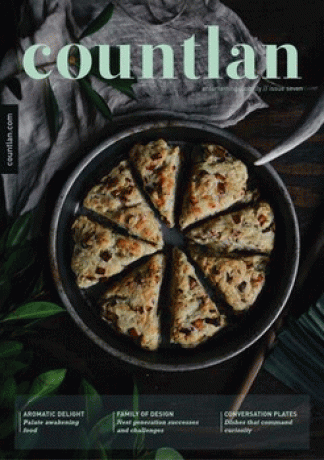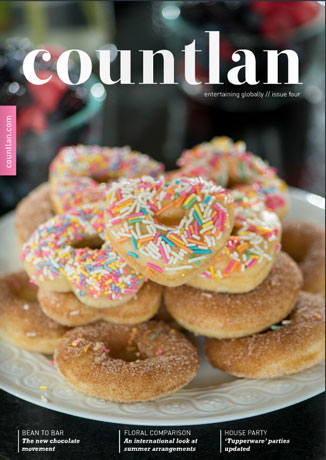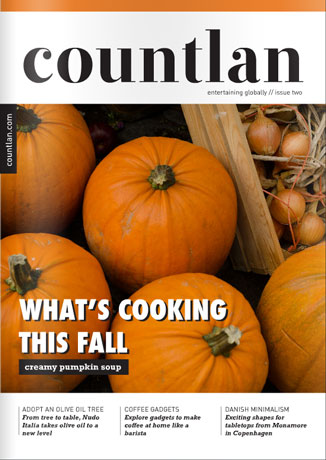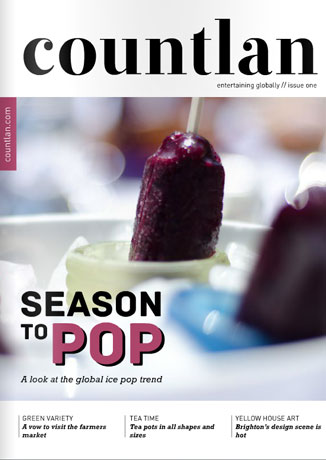
Coffee Gadgets
Issue 02
Written By: Adam Goodman
The artisanal coffee market is on fire. New cafés and coffee shops seem to be opening on every corner, each promising their customers the best coffee around. However, just as every coffee bean is different, every brewing method is unique. For coffee fanatics looking to inject some flair into their coffee preparation routine when entertaining at home, we thought we would break down all the options on the market.
The “flair” we were referring to when it comes to coffee preparation is unique to making filter, or drip coffee. North American coffee is largely drip-brewed whereas European coffee tends to be espresso-base. If you have ever had coffee in Europe, you may have noticed that menus serve espresso based coffee drinks. This is what Mark Schultz, CEO of Starbucks, experienced years ago on a trip to Italy and consequently exported to North America. Starbucks adapted the European-style espresso-based drink for the North American palate while still serving up plenty of their traditional filter coffee.
To differentiate from espresso driven or tasteless filter coffee shops, smaller indie cafés are propelling the trend of artisanal filter coffee. The move towards perfecting filter coffee in an unhurried environment has resulted in a revival of the art of filter coffee preparation and by extension, all the gadgets that accompany its brewing process.
Filter coffee is prepared in several ways. Larger coffee chains typically prepare pots of filter coffee by using an automatic machine. This coffee sits around in a thermos for a short period of time, from which it is either sold in individual cups or thrown out if it has gone stale. For example, Canadian coffee mega-chain, Tim Hortons, disposes its “always fresh” coffee after 20 minutes. This is where the independent cafés differ.
Smaller shops prepare filter coffee using gadgets like cafetières (also known as French presses), syphons, or pour-over drip cones to brew coffee on demand, ensuring that every cup is as fresh as possible.
Cafetière:
The cafetière, coffee plunger, or French press (the names are used interchangeably) can be traced back to 1852, when a patent was filed by two Frenchmen to protect the design of the plunge mechanism. In 1929, Italian designer Attilio Calimani obtained a patent for a new cafetière design by creating a seal between the plunger and the side walls, lacking in the earlier French version. The cafetière was popularised by two companies, La Cafetière and Bodum, which at one point worked together to manufacture and distribute this style of coffee maker. However, following a disagreement, the companies stopped working together and are direct competitors today.
Cafetières are available at stores, coffee shops and cafés from Starbucks to Ikea. This tool is one of the simplest and easiest manual coffee brewing machines on the market. The only major complaint is the tendency to find “coffee sludge” at the bottom of your cup.
Brewing coffee in a Cafetière:
1) Boil water in a kettle.
2) Rinse your cafetière to make sure it is free of dust. Some recommend preheating the cafetière by pouring hot water into it and letting it sit for a few moments and then pouring it out. This is said to reduce heat loss and maximize flavour.
3) Grind your beans of choice and place them in the bottom of the cafetière. A coarse grind is best.
4) Let your boiled water sit for 30 seconds before pouring it into the cafetière. This avoids scalding your coffee grinds. (Boiling water = burnt tasting coffee.)
5) Pour the hot water into the cafetière and give it a few stirs with a spoon.
6) Let the cafetière stand for approximately four minutes before slowly pushing the plunger down to the bottom of the glass. Once plunged, you are ready to pour yourself a cup.
Countlan Comments: There is much debate as to whether one should immediately empty the liquid from the cafetière after brewing or to let it sit. Leaving liquid to mix with the coffee grinds means that you will continue the brewing process and create a stronger flavour (which some people like). Other people complain that leaving liquid ruins the taste of the coffee. We will leave it up to your taste buds to decide.
Vacuum Pot or Syphon:
The syphon is one of the more advanced manual coffee makers available on the market today and it also makes for an entertaining visual experience when preparing coffee for guests at home. The syphon (or siphon) dates back to the 1830s in Germany, when a variety of European manufacturers filed patents for different designs. It was around 1915, when American company, Corning Glass, created the “Silex” syphon, a vaccum coffee maker made of Pyrex glass (a heat-resistant glass), which benefited from wide-scale distribution to hotels and cafés and rising popularity in North America. However, vaccum pot usage waned in the 1950s when other instant and more convenient coffee brewing methods emerged. Recently, a renewed interest in artisanal coffee and the cup-by-cup old-school coffee preparation method has rekindled demand for the syphon. For example, Japanese manufacturer, Hario, is taking syphon manufacturing to the next level following the introduction of its sleek designed syphons with LED heating sources.
Modern-day syphons work similarly to their predecessors: two spherical glass flasks are stacked on top of each other. The top flask has a glass tube attached to it that sits in the bottom flask. A filter (plastic or cloth) is placed in the top flask. Water is poured into the bottom flask while the coffee grinds are put into the top flask. A heat source (such as a gas hob) is applied to the bottom flask, bringing the water to a boil. As the water boils, it starts to evaporate up the glass tube into the top flask. The water transfers to the top flask and brews the coffee. The heat source is removed, and as the water cools, it returns to the bottom flask as brewed coffee, creating a bubbling sound as it descends. If you’ve never seen this for yourself, it’s worth watching. (INSERT VIDEO http://www.youtube.com/watch?v=F_T0n00LPNw)
Brewing coffee in a syphon:
1) Boil water in a kettle.
2) Place a filter in the top flask.
3) Pour boiling hot water into the bottom flask.
4) Grind your coffee beans and place them directly into the top flask. Place the top flask on top of the bottom flask.
5) Apply a heat source to the bottom flask (a small butane burner is probably the easiest heat source to use, but if you have the money to spend, an LED heat source is a sight to be seen).
6) As the water transfers to the top flask, give it a stir to ensure all coffee grinds are covered in water.
7) Reduce the heat as low as it will go, ensuring that the water stays up top. Place the cover on top of the syphon and let it stand for 70 to 90 seconds.
8) Turn off the heat source and watch the coffee transfer to the bottom flask. Your coffee is ready to be served.
Countlan Comments: It is best to use off-the-boil water to accelerate the elapsed time of brewing coffee. It is generally a good idea to let the coffee cool for a few minutes before serving.
The Pour-Over Coffee Maker:
The pour-over coffee maker is made up of two major products: the Chemex and the drip cone. Both work almost identically, with aesthetics and method as their main difference.
The Chemex (the product and company name) coffee brewing system was invented in 1941 by German inventor Peter Schlumbohm. It was (and still is) manufactured and sold by the Chemex Corporation in Massachusetts, which is now available globally. The Chemex features a glass beaker in an hourglass shape with a wooden collar and leather tie. Its cutting-edge design was highly regarded and resulted in the product’s inclusion as part of the permanent collection at the Museum of Modern Art in New York, and at the Smithsonian in Washington, DC.
What sets drip cones apart from the Chemex is that you have to place the drip cone on top of a glass or flask to capture the coffee. The drip cone is manufactured by a number of companies and comes in a variety of sizes, colours, and materials, including glass, ceramic, plastic, and metal. Perhaps the two most popular brands are Clever and Hario, though many others exist. Clever produces a plastic drip cone that has a built-in stopper, which allows you to adjust the amount of time the water and coffee grinds soak. Hario produces a variety of glass, plastic, and ceramic drip cones, with an opening at each end.
Brewing coffee using the pour-over method:
1) Boil water in the kettle and let stand for 30 seconds.
2) Place a paper filter in the opening.
3) Slightly wet the paper filter. This will remove any “papery” taste from the coffee.
4) Grind your beans, and immediately place them into the paper filter.
5) Pour enough hot water over your coffee grinds to cover them. Let the water-soaked grinds stand for 30 seconds (this allows the grinds to bloom and fully release their flavour).
6) Continue pouring water on the grinds in a circular fashion, making sure you cover all coffee grinds until you reach your desired serving size.
Countlan Comments: While it may seem that pour-over coffee makers are just a manual version of the automatic coffee machines, there are key differences worth noting. When using a pour-over coffee maker, the coffee grinds should be fully soaked, ensuring all the grinds are used. A full soaking results in a consistent flavour (more difficult or impossible to achieve with automatic machines). It also avoids the dreaded “coffee sludge” found in other brewing methods as the paper filter used in the pour-over method removes any non-liquid particles from falling into your cup.
Next time you’re thinking of entertaining, consider using a manual coffee maker. Not only will it spark conversation, but slowing down the brewing experience allows you to more fully share in the ritual, resulting in a cup you’ll savour that much more.
Interesting Coffee Shops Selling Great Beans for your Gadgets
- Coutume Café, Paris, France
- Square Mile Coffee Roasters, London, England
- Atomic Coffee Roasters, Auckland, New Zealand
- The Coffee Collective, Copenhagen, Denmark
- Blue Bottle Coffee, San Francisco, USA
- Doubleshot, Prague, Czech Republic
- Intelligentsia Coffee, Chicago, USA
- Te Aro Coffee Roasters, Toronto, Canada
- Five Elephant, Berlin, Germany
- Koppi Kaffe & Roasteri, Helsingborg, Sweden
- Tim Wendelboe, Oslo, Norway
- Heart Coffee Roasters, Portland, Oregon, USA






